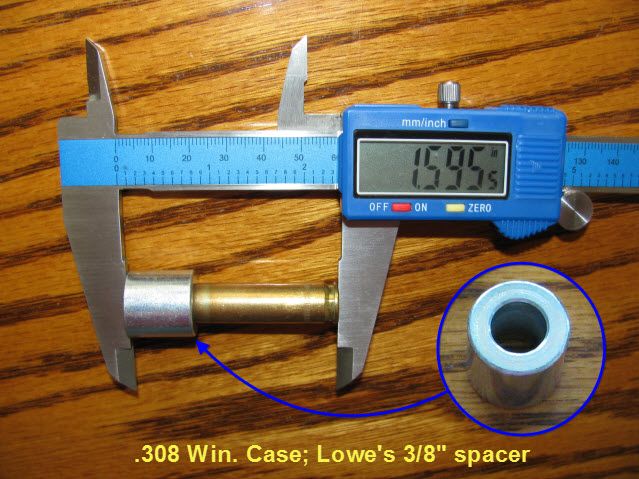Tangolima,
Does new commercial ammo fit the chamber? That's a critical question. Most new ammo I see has the case shoulders about 0.002" shorter than a SAAMI minimum chamber. If it fits, your chamber may be tight, but it's not really too tight.
Let's take advantage Mr. Guffey's method and a comparator, if you have one. If you don't, look at the improvised one in the photo below. It is for 308 Winchester, but you can certainly alter the spacer choice for your chambering. Just pick something that will contact the case shoulder in about the middle between the neck and case body. Since this is a comparator, not an absolute measuring tool, we don't care that you have something that matches the proper datum diameter exactly, as long as it repeats from one case to the next. We just want to determine shorter or longer.
What you want to do is measure the case head-to-shoulder length this way, zero the caliper, then resize the case and see if it grows (plus number) or shrinks (minus number). If it shrinks, it should be fitting in the gun and something else is wrong. In that instance, check that the case didn't get fatter. It shouldn't do that unless the die is out of spec, but you can check to be sure, anyway.
Assuming the case grows, the sizing die has narrowed the case, but failed to set the shoulder back adequately. Do check that you have a slightly compressed fit at the shell holder deck when the ram is fully up and pushing the case into the die. No crack of light should be visible between the die and shell holder deck when you put a well-illuminated white page of paper behind it and look at it sideways. But assuming you have that right, note much the comparator says the length from the head to the shoulder has grown. Remove the decapping and expanding rod from the die. Now take a second case (don't reuse the same one or you will get a false reading) and insert it into the shell holder, but this time slipping a feeler gauge between the case head and the bottom of its slot that is equal to the extra length you measured, plus one thousandth more. Repeat the experiment. Keep repeating until you find the gauge thickness that causes cases to come out of the die –0.001" shorter at the shoulder than they were when they went in (on average). That should be a very good accuracy length. Add another thousandth to come out –0.002" below the comparator length if the rifle is a self-loader. That final shim thickness is how much you would want to grind off the mouth of the die.
Most of the major die makers will grind and re-radius the die mouth to your specification for a fee, but you can do it yourself if you feel competent to do the job without getting the mouth out of square. Just keep in mind that you can also keep using the feeler gauges, so this is treating yourself to a greater convenience.
Personally, I would use a Lee die for this if one is available in your chambering. Not only are they honed very perfectly round, but they are less expensive to replace if you make a mistake doing it yourself. The finished ground die would then be only for this rifle until you shoot out the barrel and replace it, at which time you can get a normal length chamber or the same length in your next barrel, as you prefer. The chamber you have can also be cut longer if you want to do that now.
Customizing dies in this way is not unusual. Board member Hummer70 says, IIRC, he has something like 150-odd sizing dies, most of which duplicate a caliber, but which are ground to slightly different lengths or, I expect, honed to different neck diameters and that he has needed at one time or another for his various barrels in that chambering.
When you go to make the measurements, if the length of a case coming out of the sizing die is not more than a couple of thousandths longer than a fireformed case, resize it again, this time letting the case stay in the die at the top of the stroke for a count of five to let it relax. Withdraw it and rotate it 180°, and repeat. That may shorten it as much further as you need, assuming you are willing to spend the extra time. The additional shortening is the reason I recommended using fresh cases for determining how much shorter the die needs to be.
If your press is being overcome by the sizing force, you will see that crack of light and should be able to keep turning the die in, a little at a time (like a tenth of a turn at a time) until it disappears. If, for example, you follow die instructions for an iron press made by Lyman or RCBS or Redding, but are using a cast aluminum frame Lee press, since aluminum has a lower modulus of elasticity, you should expect the press to stretch more and the die to need to be turned in further. Follow Lee's instructions (available from their site) instead of the ones that came with the die, or else nudge it in as I described.

